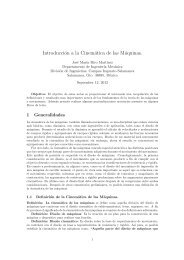Sistema Vibratorio de un Grado de Libertad Amortiguado - fimee ...
Sistema Vibratorio de un Grado de Libertad Amortiguado - fimee ...
Sistema Vibratorio de un Grado de Libertad Amortiguado - fimee ...
Create successful ePaper yourself
Turn your PDF publications into a flip-book with our unique Google optimized e-Paper software.
eal. De hecho, <strong>de</strong> la teoría <strong>de</strong> las ecuaciones diferenciales lineales,<br />
se sabe que la solución general <strong>de</strong> <strong>un</strong>a ecuación diferencial lineal <strong>de</strong><br />
seg<strong>un</strong>do or<strong>de</strong>n constituye <strong>un</strong> espacio vectorial <strong>de</strong> dimensión 2 en el espacio<br />
vectorial <strong>de</strong> f<strong>un</strong>ciones reales continuamente diferenciables. De<br />
manera que si se encuentran dos f<strong>un</strong>ciones reales, que sean:<br />
(a) Soluciones <strong>de</strong> la ecuación diferencial dada por la ecuación (4),<br />
digamos yr1(t) yyr2(t),<br />
(b) Que las f<strong>un</strong>ciones sean linealmente in<strong>de</strong>pendiente.<br />
Entonces la solución general <strong>de</strong> la ecuación (4), yG(t), estará dadapor<br />
<strong>un</strong>a combinación lineal <strong>de</strong> las dos soluciones, es <strong>de</strong>cir<br />
yG(t) =C1 yr1(t)+C2 yr2(t).<br />
La pista para encontrar estas soluciones reales está dada por la i<strong>de</strong>ntidad<br />
<strong>de</strong> Euler, que indica que<br />
e +iωn<br />
<br />
e −iωn<br />
<br />
1−( c<br />
cc )2 t = Cos<br />
1−( c<br />
cc )2 t = Cos<br />
<br />
ωn 1 − (c/cc) 2<br />
<br />
<br />
ωn 1 − (c/cc) 2<br />
<br />
<br />
t + iSen ωn 1 − (c/cc) 2<br />
<br />
t<br />
<br />
t − iSen ωn 1 − (c/cc) 2<br />
<br />
t<br />
Por lo tanto, dos candidatos naturales <strong>de</strong> las soluciones reales <strong>de</strong> la<br />
ecuación (4) son<br />
y<br />
c<br />
−<br />
yr1(t) =e cc ωn t <br />
Cos ωn 1 − (c/cc) 2<br />
<br />
t<br />
c<br />
−<br />
yr2(t) =e cc ωn t <br />
Sen ωn 1 − (c/cc) 2<br />
<br />
t,<br />
es fácil probar que ambas f<strong>un</strong>ciones candidatas son soluciones <strong>de</strong> la<br />
ecuación diferencial, <strong>de</strong> manera que la solución general <strong>de</strong> la ecuación<br />
(4) está dada por<br />
<br />
c<br />
− ωn t<br />
yG(t) =e cc ACos ωn 1 − (c/cc) 2<br />
<br />
<br />
t + BSen ωn 1 − (c/cc) 2<br />
<br />
t<br />
don<strong>de</strong> A y B son constantes arbitrarias.<br />
8<br />
(14)



